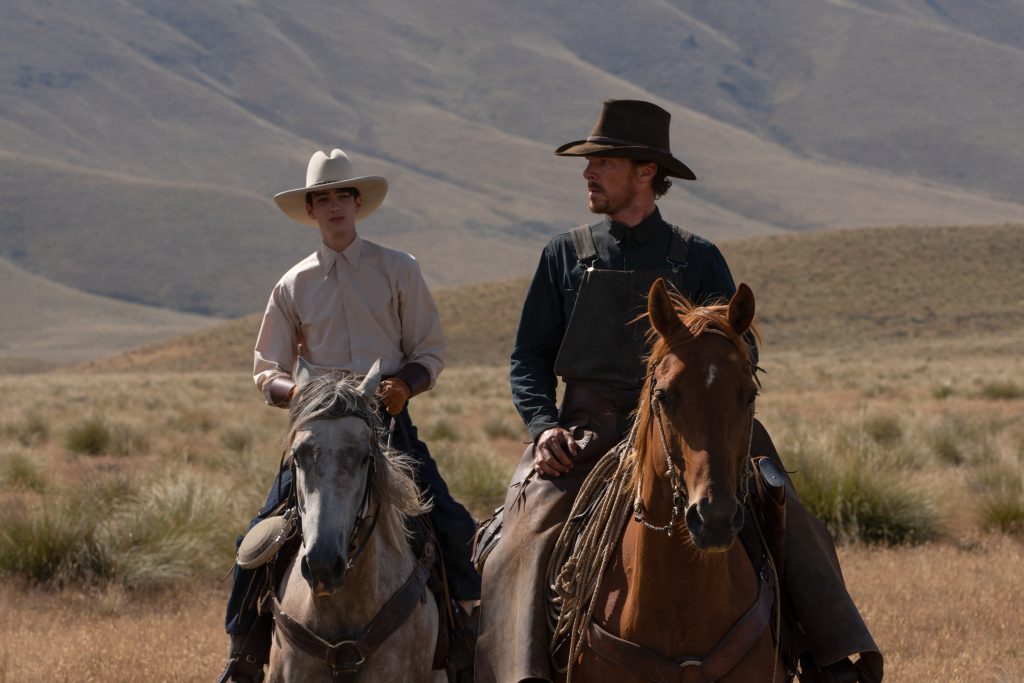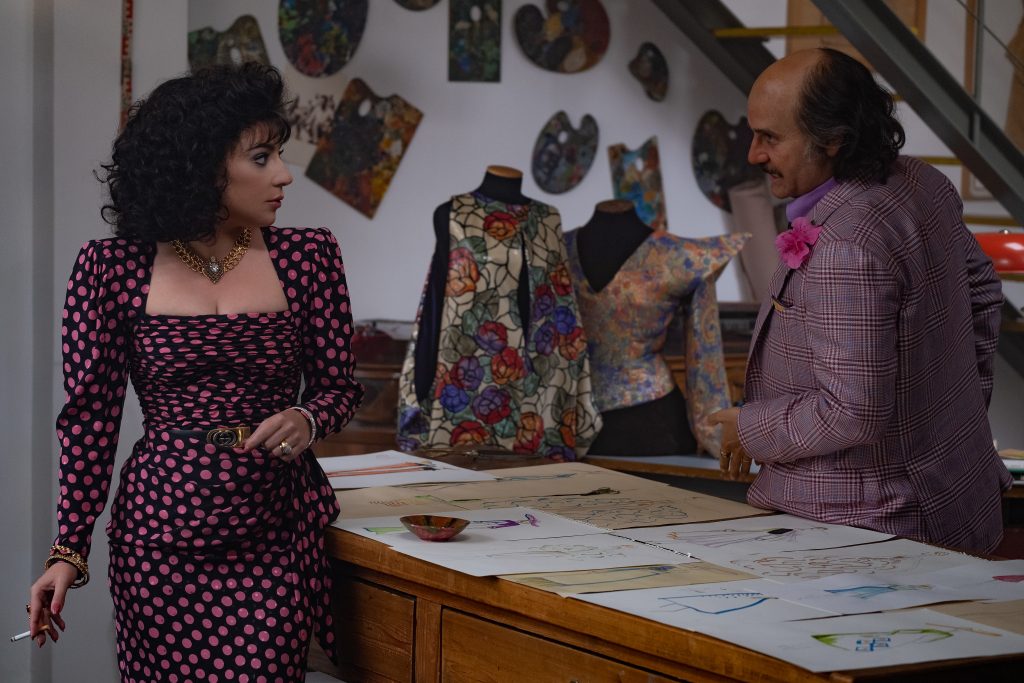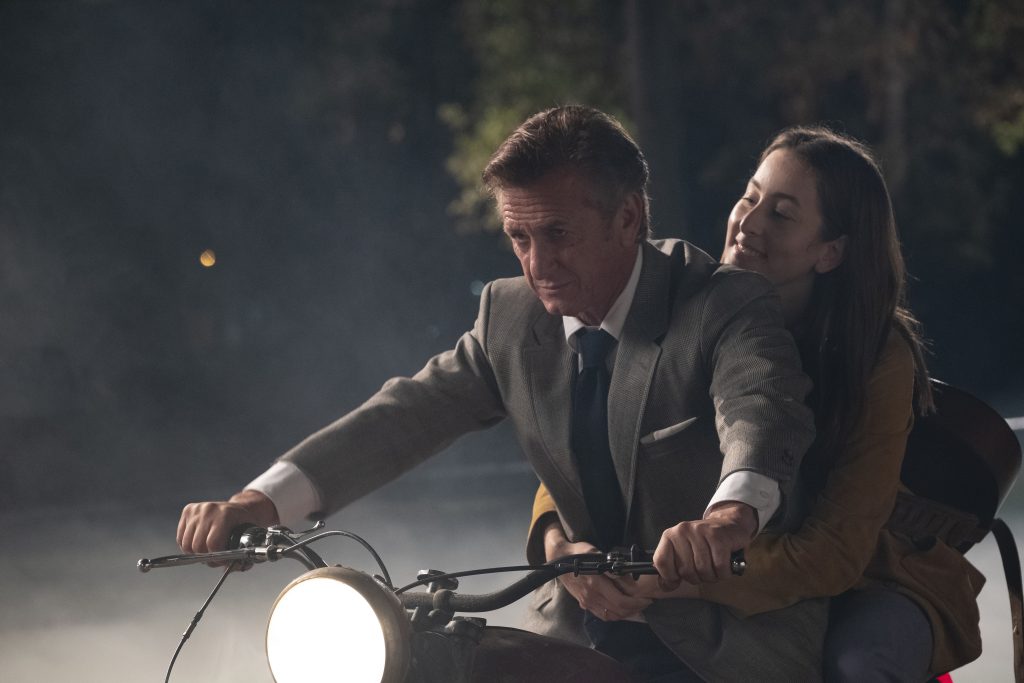February 8, 2022
by Carla Hay

With 12 nods, the Netflix drama “The Power of the Dog” is the top nominee for the 94th Annual Academy Awards, which will take place at the Dolby Theatre in Los Angeles on March 27, 2022. ABC will have the U.S. telecast of the show. The nominations were announced on February 8, 2022, by Tracee Ellis Ross and Leslie Jordan.
The nominations for “The Power of the Dog” are Best Picture; Best Actor (for Benedict Cumberbatch); Best Director (for Jane Campion); two nods for Best Supporting Actor (for Jesse Plemons and Kodi Smit-McPhee); Best Supporting Actress (for Kirsten Dunst); Best Adapted Screenplay; Best Film Editing; Best Cinematography; Best Production Design; Best Original Score; and Best Sound. The movie, which is set in 1925 Montana, is about a rancher family that is plagued by jealousy, toxic masculinity and homophobia. Dunst and Plemons are a couple in real life (and they portray a married couple in “The Power of the Dog”), so their nominations are a rare situation where a co-star couple received Oscar nominations for the same movie.
The other contenders for Best Picture are Focus Features’ “Belfast,” Apple Studios’ “CODA,” Netflix’s “Don’t Look Up,” Janus Films/Bitters End’s “Drive My Car,” Warner Bros. Pictures’ “Dune,” Warner Bros. Pictures’ “King Richard,” United Artists/Focus Features’ “Licorice Pizza,” Searchlight Pictures’ “Nightmare Alley” and 20th Century Studios’ “West Side Story.” The 2021 remake of “Dune” had the second-highest number of Oscar nominations this year (10 nods), followed by “Belfast” and “West Side Story,” which had seven nods each. (Click here to read Culture Mix’s reviews of all these movies that are nominated for Best Picture.)
The awards are voted for by the Academy of Motion Picture Arts and Sciences. For the 2022 ceremony, eligible movies were those released in the U.S. cinemas in 2021. As of 2022, the Academy is requiring the Best Picture category to have 10 nominees. From 2009 to 2021, the rule was that there could be five to 10 movies per year nominated for Best Picture.
Snubs and Surprises

It’s been an unpredictable awards season for the Best Actress category. Lady Gaga of MGM/United Artists’ “House of Gucci” has been getting nominated at every major award ceremony for movies—except for the Academy Awards, where she was widely predicted to get a nomination. Meanwhile, Kristen Stewart of Neon’s “Spencer” was chosen by many awards pundits as an early frontrunner for a Best Actress Oscar, but Stewart’s performance in “Spencer” ultimately failed to get nominations at the Screen Actors Guild Awards and the BAFTA Film Awards—two major award shows that often indicate who will be Oscar winners and Oscar nominees. Despite those snubs, Stewart scored her first Oscar nomination for “Spencer,” when many awards pundits counted her out of the Oscar race because of the SAG and BAFTA snubs. Stewart’s nomination for Best Actress is the only Oscar nod for “Spencer.”
The category of Best Supporting Actor and Best Supporting Actress had a few snubs and surprises. Caitríona Balfe of “Belfast” was getting nominated at every major award show for movies—except for the Academy Awards. Instead, “Belfast” co-star Judi Dench got an Oscar nomination for Best Supporting Actress, even though Dench was passed over in this category for “Belfast” at other major award shows. For “The Power of the Dog,” Best Supporting Actor nominee Smit-McPhee was widely predicted to get an Oscar nomination, but “Power of the Dog” co-star/Oscar nominee Plemons failed to get a Best Supporting Actor nod at other major awards shows, except for the BAFTAs. Meanwhile, Jared Leto of “House of Gucci” was shut out of an Oscar nomination for the Best Supporting Actor category for this movie. Leto has been nominated at other award shows for “House of Gucci,” which got an expected Oscar nomination for Best Makeup and Hairstyling that includes the much-talked-about prosthetic makeup that Leto wore in the movie. (It’s the only Oscar nod for “House of Gucci.”)
Movies that have been getting awards or nominations elsewhere were completely snubbed by the Academy Awards. They include the Netflix drama “Passing,” the Focus Features comedy “The French Dispatch,” the Netflix drama “The Harder They Fall” and the A24 drama “C’mon C’mon.” Movies that win the Academy Award for Best Picture always get a screenplay Oscar nomination too. That’s why “Nightmare Alley” and “West Side Story” (which are both remake films) have little or no chance to win Best Picture, since both movies failed to get Oscar nominations for Best Adapted Screenplay. In the category of Best Film Editing, “Belfast” and “West Side Story” were snubbed, even though both movies were widely predicted to get Oscar nods in that category. And although “Dune” earned a massive 10 Oscar nominations, one of them wasn’t for director Denis Villeneuve in the Best Director category, although he did get an expected Best Adapted Screenplay nod for co-writing the movie.
Some of the biggest surprise nominations came from international films. Neon’s Danish movie “Flee” (directed by Jonas Poher Rasmussen) made Oscar history for being the first movie to get Oscar nominations for Best International Feature Film, Best Animated Feature and Best Documentary Feature. While many pundits had floated the possibility that these three nominations would happen for “Flee,” many people predicted that “Flee” would get one or two Oscar nominations. “Flee” is an Afghan refugee’s first-hand account of his life, which is depicted in animated form. He currently lives in Denmark and used an alias in the movie to protect his privacy. Neon’s Norwegian drama “The Worst Person in the World” was expected to get a nomination for Best International Feature Film, but a surprise nomination came when the movie got an Oscar nod for Best Original Screenplay. “The Worst Person in the World” was written by Joachim Trier (the movie’s director) and Eskil Vogt.
Diversity and Inclusion

“The Power of the Dog” director Campion made Academy Awards history, by becoming the first woman to get two Oscar nominations for Best Director. She was previously nominated for 1993’s “The Piano,” but lost the award to “Schindler’s List” director Steven Spielberg. It’s a rematch of sorts for Campion and “West Side Story” director Spielberg, since they’re both nominated again for Best Director in the same year. In another male-dominated category (Best Cinematography), Ari Wegner of “The Power of the Dog” became the second woman ever to get an Oscar nomination for Best Cinematography. The first woman to break this Best Cinematography gender barrier was Rachel Morrison, who was nominated for another Netflix period drama: 2017’s “Mudbound.”
Racial diversity is in every actor/actress category at 2022 Academy Awards, except for Best Supporting Actor. Black people are represented the most with “King Richard,” which has six nominations: Best Picture; Best Actor (for Will Smith); Best Supporting Actress (for Aunjanue Ellis); Best Original Screenplay; Best Film Editing; and Best Original Song (for Beyoncé’s “Be Alive”). “King Richard” is a biopic about Richard “Richie” Williams, the father and early coach of tennis superstars Venus Williams and Serena Williams.
Two African American-oriented films were nominated for Best Documentary Feature this year: Showtime’s “Attica” (directed by Stanley Nelson and Traci A. Curry) and Searchlight Pictures’ “Summer of Soul (…Or, The Revolution Could Not Be Televised”), directed by Ahmir “Questlove” Thompson. Meanwhile, Denzel Washington scored his 10th Oscar nomination: Best Actor, for A24/Apple TV+’s “The Tragedy of Macbeth,” making him the most Oscar-nominated African American in Academy Awards history. Nine of his Oscar nominations are for acting, while one nomination is a Best Picture nod for being a producer of 2016’s “Fences.” Washington has won two Oscars: Best Actor (for 2001’s “Training Day”) and Best Supporting Actor (for 1989’s “Glory”).
Asians were represented the most with “Drive My Car,” a Japanese drama about a grieving widower who goes on a road trip with a young actress. “Drive My Car” earned four Oscar nods: Best Picture; Best Director (for Ryusuke Hamaguchi); Best Adapted Screenplay; and Best International Feature Film. As previously mentioned, “Flee” is about an Afghan refugee. Two other Asian-oriented movies were nominated for Best Documentary Feature: MTV Documentary Films’ “Ascension” (about consumerism in China) and Music Box Films’ “Writing With Fire” (about Indian female journalists). Chinese American director Jessica Kingdon is one of the nominees for “Ascension” while Indian American directors/producers Rintu Thomas and Sushmit Ghosh are nominated for “Writing With Fire.”
Disney’s “Raya and the Last Dragon,” which takes place in China and has an all-Asian cast, is nominated for Best Animated Feature, but none of the nominated producers and directors of the movie is Asian. Pakastani British entertainer Riz Ahmed, who got an Oscar nomination for Best Actor in 2021 for the Amazon Studios drama “Sound of Metal,” is nominated for an Oscar in 2022—this time, for being a producer of “The Long Goodbye,” which is nominated for Best Live-Action Short. Meanwhile, Indian American producer Joseph Patel is one of the Best Documentary Feature nominees for “Summer of Soul (…Or, When the Revolution Could Not Be Televised).”
Hispanic/Latino people nominated for Oscars this year included Oscar-winning spouses Javier Bardem of “Being the Ricardos” (Best Actor) and Penélope Cruz of “Parallel Mothers” (Best Actress); Guillermo del Toro (Best Picture), for being one of the producers of “Nightmare Alley”; “Parallel Mothers” composer Alberto Iglesias (Best Original Score); “Raya and the Last Dragon” co-director Carlos López Estrada (Best Animated Feature); and Ariana DeBose of “West Side Story” (Best Supporting Actress). DeBose, who is multiracial (Hispanic, African American and white) in real life, depicts a Puerto Rican in the 2021 remake of “West Side Story” and is the only cast member and the only person of color to get an Oscar nomination for the movie. “West Side Story” is a musical about racial tensions between white people and Puerto Ricans in early 1960s New York City.
Disney’s Colombian-oriented animated film “Encanto” picked up three nominations: Best Animated Feature (whose nominees includes Latina producer Yvett Marino); Best Original Song (for “Dos Oruguitas,” written by Lin-Manuel Miranda); and Best Original Score (for Germaine Franco, one of the few women ever nominated in this category). Meanwhile, there are Latino nominees in the short film categories: Best Animated Short nominees include writer/director Hugo Covarrubias and producer Tevo Díaz of “Bestia (Beast)” and writer/director Alberto Mielgo and producer Leo Sanchez of “The Windshield Wiper.” “Please Hold” director K.D. Dávila is nominated for Best Live-Action Short.
LGBTQ representation in the Oscar nominations can be found in the animated documentary “Flee” (whose subject is a gay Afghan refugee); Cruz’s queer character Janis Martínez Moreno in “Parallel Mothers” and Cumberbatch’s closeted gay character Phil Burbank in “The Power of the Dog.” In real life, Stewart of “Spencer” and DeBose of “West Side Story” identify as openly queer. The disabled community is represented by “CODA” (about a Massachusetts family of mostly deaf people), which got three nominations: Best Picture, Best Supporting Actor (for real-life deaf actor Troy Kotsur); and Best Adapted Screenplay.
Here is the complete list of nominations for the 2022 Academy Awards:
Best Picture
“Belfast,” Laura Berwick, Kenneth Branagh, Becca Kovacik and Tamar Thomas, producers
“CODA,” Philippe Rousselet, Fabrice Gianfermi and Patrick Wachsberger, producers
“Don’t Look Up,” Adam McKay and Kevin Messick, producers
“Drive My Car,” Teruhisa Yamamoto, producer
“Dune,” Mary Parent, Denis Villeneuve and Cale Boyter, producers
“King Richard,” Tim White, Trevor White and Will Smith, producers
“Licorice Pizza,” Sara Murphy, Adam Somner and Paul Thomas Anderson, producers
“Nightmare Alley,” Guillermo del Toro, J. Miles Dale and Bradley Cooper, producers
“The Power of the Dog,” Jane Campion, Tanya Seghatchian, Emile Sherman, Iain Canning and Roger Frappier, producers
“West Side Story,” Steven Spielberg and Kristie Macosko Krieger, producers
Best Director
Kenneth Branagh (“Belfast”)
Ryûsuke Hamaguchi (“Drive My Car”)
Paul Thomas Anderson (“Licorice Pizza”)
Jane Campion (“The Power of the Dog”)
Steven Spielberg (“West Side Story”)
Best Actor in a Leading Role
Javier Bardem (“Being the Ricardos”)
Benedict Cumberbatch (“The Power of the Dog”)
Andrew Garfield (“Tick, Tick … Boom!”)
Will Smith (“King Richard”)
Denzel Washington (“The Tragedy of Macbeth”)
Best Actress in a Leading Role
Jessica Chastain (“The Eyes of Tammy Faye”)
Olivia Colman (“The Lost Daughter”)
Penélope Cruz (“Parallel Mothers”)
Nicole Kidman (“Being the Ricardos”)
Kristen Stewart (“Spencer”)
Best Actor in a Supporting Role
Ciarán Hinds (“Belfast”)
Troy Kotsur (“CODA”)
Jesse Plemons (“The Power of the Dog”)
J.K. Simmons (“Being the Ricardos”)
Kodi Smit-McPhee (“The Power of the Dog”)
Best Actress in a Supporting Role
Jessie Buckley (“The Lost Daughter”)
Ariana DeBose (“West Side Story”)
Judi Dench (“Belfast”)
Kirsten Dunst (“The Power of the Dog”)
Aunjanue Ellis (“King Richard”)
Best Adapted Screenplay
“CODA,” screenplay by Siân Heder
“Drive My Car,” screenplay by Ryusuke Hamaguchi, Takamasa Oe
“Dune,” screenplay by Jon Spaihts and Denis Villeneuve and Eric Roth
“The Lost Daughter,” written by Maggie Gyllenhaal
“The Power of the Dog,” written by Jane Campion
Best Original Screenplay
“Belfast,” written by Kenneth Branagh
“Don’t Look Up,” screenplay by Adam McKay; story by Adam McKay and David Sirota
“King Richard,” written by Zach Baylin
“Licorice Pizza,” written by Paul Thomas Anderson
“The Worst Person in the World,” written by Eskil Vogt, Joachim Trier
Best Cinematography
“Dune,” Greig Fraser
“Nightmare Alley,” Dan Laustsen
“The Power of the Dog,” Ari Wegner
“The Tragedy of Macbeth,” Bruno Delbonnel
“West Side Story,” Janusz Kaminski
Best Film Editing
“Don’t Look Up,” Hank Corwin
“Dune,” Joe Walker
“King Richard”, Pamela Martin
“The Power of the Dog,” Peter Sciberras
“Tick, Tick…Boom!” Myron Kerstein and Andrew Weisblum
Best Sound
“Belfast,” Denise Yarde, Simon Chase, James Mather and Niv Adiri
“Dune,” Mac Ruth, Mark Mangini, Theo Green, Doug Hemphill and Ron Bartlett
“No Time to Die,” Simon Hayes, Oliver Tarney, James Harrison, Paul Massey and Mark Taylor
“The Power of the Dog,” Richard Flynn, Robert Mackenzie and Tara Webb
“West Side Story,” Tod A. Maitland, Gary Rydstrom, Brian Chumney, Andy Nelson and Shawn Murphy
Best Original Score
“Don’t Look Up,” Nicholas Britell
“Dune,” Hans Zimmer
“Encanto,” Germaine Franco
“Parallel Mothers,” Alberto Iglesias
“The Power of the Dog,” Jonny Greenwood
Best Original Song
“Be Alive” from “King Richard,” music and lyric by Dixson and Beyoncé Knowles-Carter
“Dos Oruguitas” from “Encanto,” music and lyric by Lin-Manuel Miranda
“Down to Joy” from “Belfast,” music and lyric by Van Morrison
“No Time To Die” from “No Time to Die,” music and lyric by Billie Eilish and Finneas O’Connell
“Somehow You Do” from “Four Good Days,” music and lyric by Diane Warren
Best Animated Feature Film
“Encanto,” Jared Bush, Byron Howard, Yvett Merino and Clark Spencer
“Flee,” Jonas Poher Rasmussen, Monica Hellström, Signe Byrge Sørensen and Charlotte De La Gournerie
“Luca,” Enrico Casarosa and Andrea Warren
“The Mitchells vs. the Machines,” Mike Rianda, Phil Lord, Christopher Miller and Kurt Albrecht
“Raya and the Last Dragon,” Don Hall, Carlos López Estrada, Osnat Shurer and Peter Del Vecho
Best International Feature Film
“Drive My Car” (Japan)
“Flee” (Denmark)
“The Hand of God” (Italy)
“Lunana: A Yak in the Classroom” (Bhutan)
“The Worst Person in the World” (Norway)
Best Documentary Feature
“Ascension,” Jessica Kingdon, Kira Simon-Kennedy and Nathan Truesdell
“Attica,” Stanley Nelson and Traci A. Curry
“Flee,” Jonas Poher Rasmussen, Monica Hellström, Signe Byrge Sørensen and Charlotte De La Gournerie
“Summer of Soul (…Or, When the Revolution Could Not Be Televised),” Ahmir “Questlove” Thompson, Joseph Patel, Robert Fyvolent and David Dinerstein
“Writing With Fire,” Rintu Thomas and Sushmit Ghosh
Best Makeup and Hairstyling
“Coming 2 America,” Mike Marino, Stacey Morris and Carla Farmer
“Cruella,” Nadia Stacey, Naomi Donne and Julia Vernon
“Dune,” Donald Mowat, Love Larson and Eva von Bahr
“The Eyes of Tammy Faye,” Linda Dowds, Stephanie Ingram and Justin Raleigh
“House of Gucci,” Göran Lundström, Anna Carin Lock and Frederic Aspiras
Best Costume Design
“Cruella,” Jenny Beavan
“Cyrano,” Massimo Cantini Parrini and Jacqueline Durran
“Dune,” Jacqueline West and Robert Morgan
“Nightmare Alley,” Luis Sequeira
“West Side Story,” Paul Tazewell
Best Production Design
“Dune,” production design: Patrice Vermette; set decoration: Zsuzsanna Sipos
“Nightmare Alley,” production design: Tamara Deverell; set decoration: Shane Vieau
“The Power of the Dog,” production design: Grant Major; set decoration: Amber Richards
“The Tragedy of Macbeth,” production design: Stefan Dechant; set decoration: Nancy Haigh
“West Side Story,” production design: Adam Stockhausen; set decoration: Rena DeAngelo
Best Visual Effects
“Dune,” Paul Lambert, Tristan Myles, Brian Connor and Gerd Nefzer*
“Free Guy,” Swen Gillberg, Bryan Grill, Nikos Kalaitzidis and Dan Sudick
“No Time to Die,” Charlie Noble, Joel Green, Jonathan Fawkner and Chris Corbould
“Shang-Chi and the Legend of the Ten Rings,” Christopher Townsend, Joe Farrell, Sean Noel Walker and Dan Oliver
“Spider-Man: No Way Home,” Kelly Port, Chris Waegner, Scott Edelstein and Dan Sudick
Best Documentary Short Subject
“Audible,” Matt Ogens and Geoff McLean
“Lead Me Home,” Pedro Kos and Jon Shenk
“The Queen of Basketball,” Ben Proudfoot
“Three Songs for Benazir,” Elizabeth Mirzaei and Gulistan Mirzaei
“When We Were Bullies,” Jay Rosenblatt
Best Animated Short Film
“Affairs of the Art,” Joanna Quinn and Les Mills
“Bestia,” Hugo Covarrubias and Tevo Díaz
“Boxballet,” Anton Dyakov
“Robin Robin,” Dan Ojari and Mikey Please
“The Windshield Wiper,” Alberto Mielgo and Leo Sanchez
Best Live-Action Short Film
“Ala Kachuu – Take and Run,” Maria Brendle and Nadine Lüchinger
“The Dress,” Tadeusz Łysiak and Maciej Ślesicki
“The Long Goodbye,” Aneil Karia and Riz Ahmed
“On My Mind,” Martin Strange-Hansen and Kim Magnusson
“Please Hold,” K.D. Dávila and Levin Menekse


